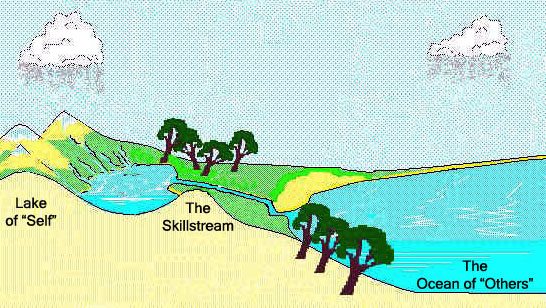Swimming in the Stream
“Character develops itself in the stream of life.”
– Johann Wolfgang von Goethe, Statesman
Much of counseling and parenting has been based around the belief that the power to live well is a thing instilled at birth. It may be fostered or frustrated by upbringing and the trials of life, but it’s something “we had somewhere within.” Thus, the goal of living is to bring forth and develop those “as yet unexpressed effective…and healthy…skills for satisfying daily living” (Goldstein, et. al. 1997).
Psychoanalytic theory holds that our unhealthy behavior is the result of unsuccessful attempts to achieve that goal, which sometimes required the help of counselors and parents to sort out. This was observed an upheld by grandparents of psychoanalysis like Freud, Steven Adler, and Carl Rogers and is still upheld by countless psychotherapists—myself included.
But what if that were not so? What if people never had it in them to resolve conflict with kindness, or to fulfil their needs without selfishness or to express affection without fear? This is the proposition of Skillstreaming; Unhealthy behavior is not the result of ill-expressed inner abilities, but evidence of the lack of the skills one needs to live well.
While the latter therapeutic concepts are born out of traditional psychological perspectives, the seeds of Skillstreaming were sown in educational soil, germinated in the Social Learning Theory of Albert Bandura and have borne fruit in behavioral support classrooms across the country for the last thirty years.
Much like the word “stream” that is the verb in Skillstreaming indicates a flowing continuum, we can help teens remove log jams or build channels using both psychoanalytic and skills training methods, rather than choosing one perspective over the other, which often just muddies the waters of parenting and counseling.
Take the diagram below (modified from a science text). No matter from a psychoanalytic or Skillstream approach “personality change as both the target and outcome of effective treatment” (Goldstein, et. al. 1997). This personality change unites the isolated “Lake of the Self” with the “Ocean of Others.” Social and behavioral problems occur when there are blockages to the stream between them, or when the stream itself is not channeled out. Regardless of the method, our role as parents and counselors is to ensure that the stream flows well.
A River Runs Through It
“No stream rises higher than its source.”
– Frank Lloyd Wright, Architect
In essence Skillstreaming is simple, and therefore elegant; we learn by seeing, imitating and experiencing results. So, in Skillstreaming we group adolescents together based on healthy similarities as well as similar skill-needs, such as conflict resolution, communication or anger management. We give them a Skills Trainer to model correct social behavior, and we have them self-identify their needs then role-play out ways to meet those needs healthily using step-by-step instruction on the skills in a lesson plan. This method was pioneered by Dr. Albert P. Goldstein and Dr. Ellen McGinnis (1997) and continues on with Dr. McGinnis today. Their work (below) is still being updated, last in 2011, and used in schools and facilities throughout the world.
There is much that traditional group therapists can learn from the Skillstreaming approach, most importantly, the structure. Especially working with children and teens, groups that are standard “process” groups can be boring, confusing, and unfocused which can become intimidating or promote resistance. However, in Skillstreaming, the intervention is action-based and patterned. The Skills Trainer defines the purpose and procedure of each group, helps the teens define personal incentives to using a skill correctly (“I’ll fight with my brother less” or “I’ll get what I want from mom”) gains acknowledgment of the group rules then spends the rest of the time in instruction and role-play practice (Goldstein, et. al. 1997).
There is also much that Skillstreaming can benefit from in traditional group therapy. As the teen seeks to find the personal incentive to build a skill, Goldstein notes that they can have an “inaccurate self-picture” in which they are never to blame for the responses their actions incur. Sound familiar, parents? Interventions using the Stages of Change or Motivational Interviewing would help build that personal incentive. This incentive appears key to success according to Amy Evans and Candice Stefanou’s report at the 2009 Northeastern Educational Research Association (NERA) Annual Conference.
The report found that Skillstreaming “is a moderately effective intervention at post-treatment for children and adolescents,” but they noted that “at this point [it] is inconclusive for whom the intervention is most effective” because among the study-group of teens “no significant effects were found for…Social Skills, Problem Behaviors or Academic Competence” but the skill of Cooperation was positively affected. (Evans and Stephanou, 2009, p. 9)
The Stream Never Stops
“Time is but the stream I go a-fishing in.”
– Henry David Thoreau, Writer
Of course, there is countless evidence proving the effectiveness of Skillstreaming which is why Evans and Stephanou (2009) encouraged trainers to look at building incentive in the teens, and making sure that the skills were generalized, or put into practice over different settings. This is another area that group therapy can aid in, as Goldstein wrote that “assuming perspective of the skill target-person” increased generalization (1997, 195). There are many group therapy techniques that involve seeing a situation or interaction from the other person’s perspective.
Goldstein and McGinnis themselves “urge consideration of an additional…array of companion psychological competencies, coordinated with social skill instruction” as a means to improve the NERA reports findings because it “…yields evidence of relatively long-term skill use” (1997 p.198).
Family therapy would also address the findings, as Evans and Stephanou said that “another explanation…is that changing perceptions of others may be more difficult to do than changing behavior itself” (2009, p. 14). Though Skillstreaming, in prioritizing staff and parent review of skills and in-the-moment encouragement puts parents in the role of coach and cheerleader, the changes the teens had been making in problem behaviors and social skills may have required greater awareness and “unpacking” with parents than just study responses.
We all swim in the Ocean of Others. As adults we know how choppy the water can be. The deeper we know our “Lake of Self” and stronger our stream flows, the better we can swim in those waters. The thing about a stream is it’s flowing whether we like it or not. The ocean is coming. Parenting, counseling, therapy, Skillstreaming, they are all just ways to help our kids become better swimmers now and for the ocean ahead.
__________________________________________________
Evans, A. and Stefanou, C. (2009) Behavioral and academic effects of Skillstreaming the Adolescent for at-risk middle school students. Northeastern Educational Research Association (NERA) Annual Conference Report. Retrieved from: http://digitalcommons.uconn.edu/cgi/viewcontent.cgi?article=1004&context=nera_2009
Goldstein, A. and McGinnis, E. et. Al. (1997) Skillstreaming the Adolescent. Research Press. Current Edition 2011, McGinnis, E.
Also Congratulations to Francoisome (part of your email supplied) you won the $5 Amazon Gift Card! Please contact me within the next two weeks and I’ll send it to you. Yay! Everyone else, thanks for subscribing, and if you haven’t yet, subscribe! You could be next.




